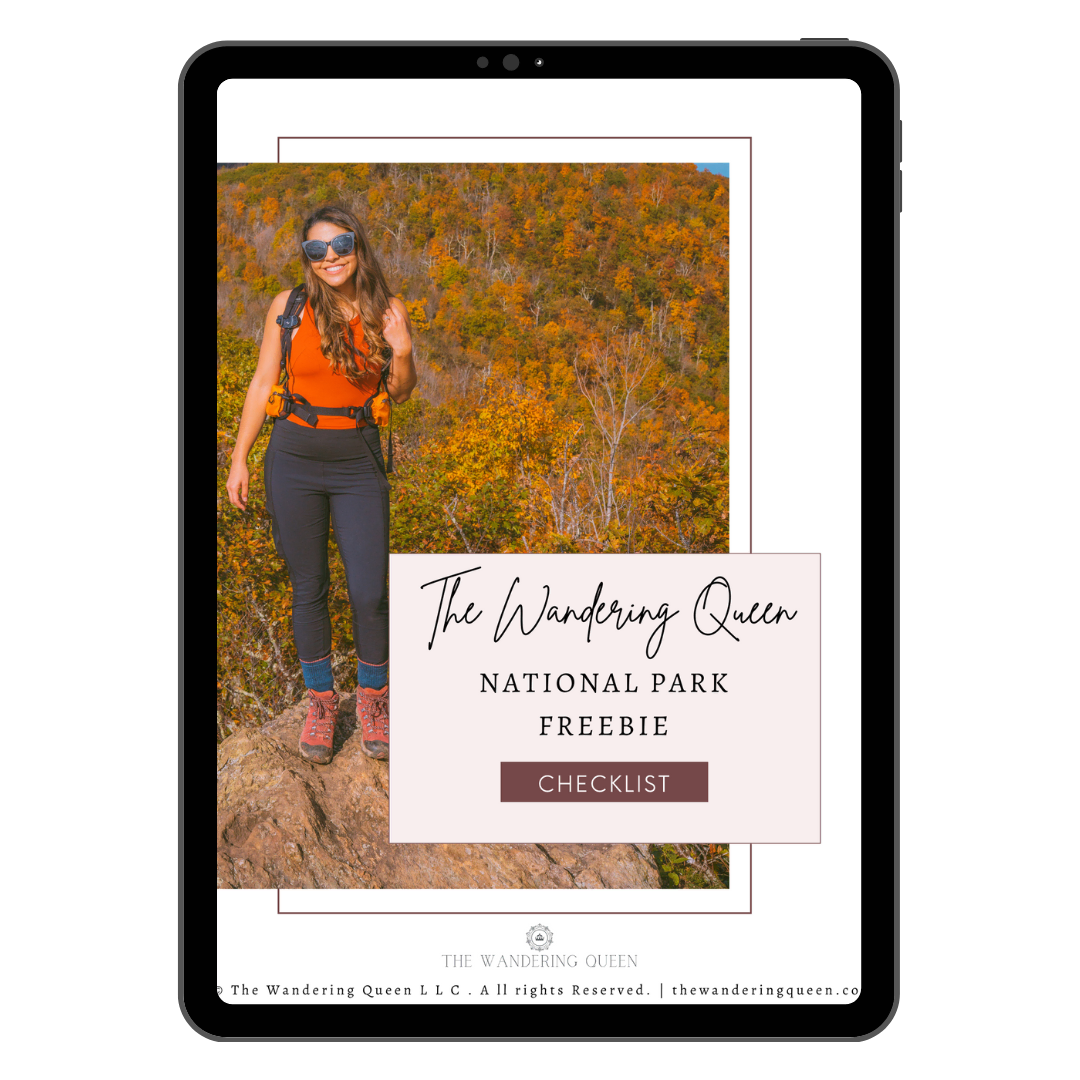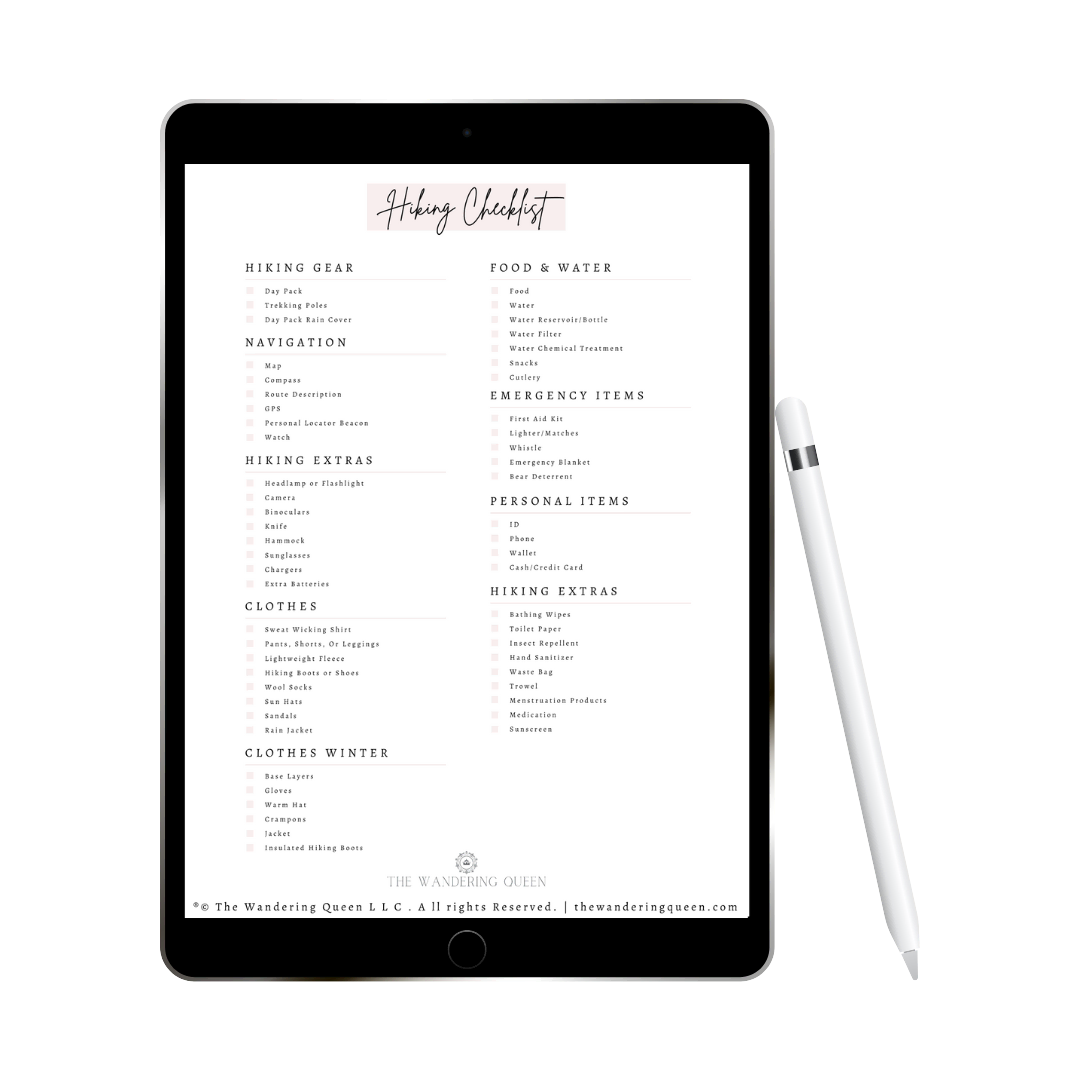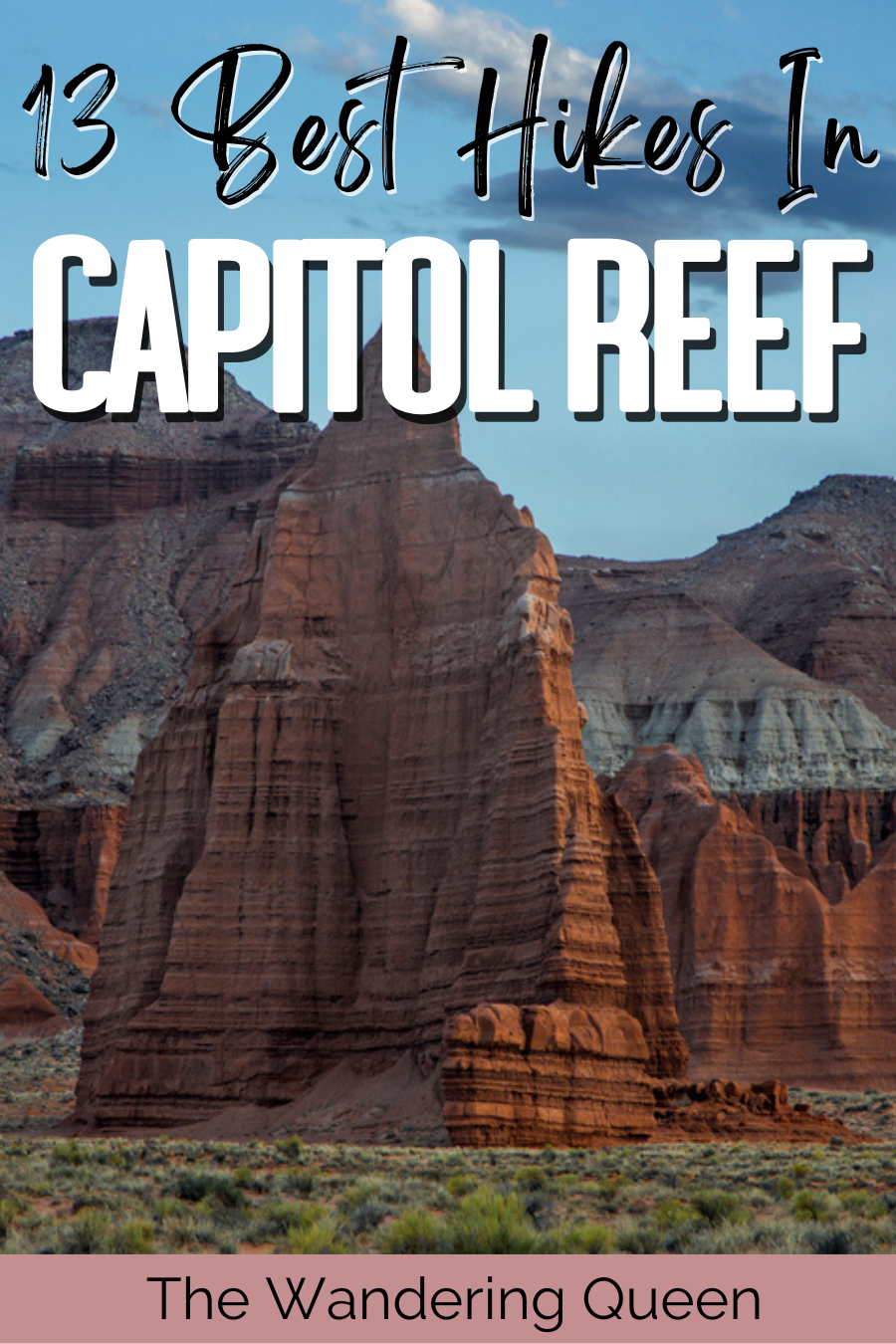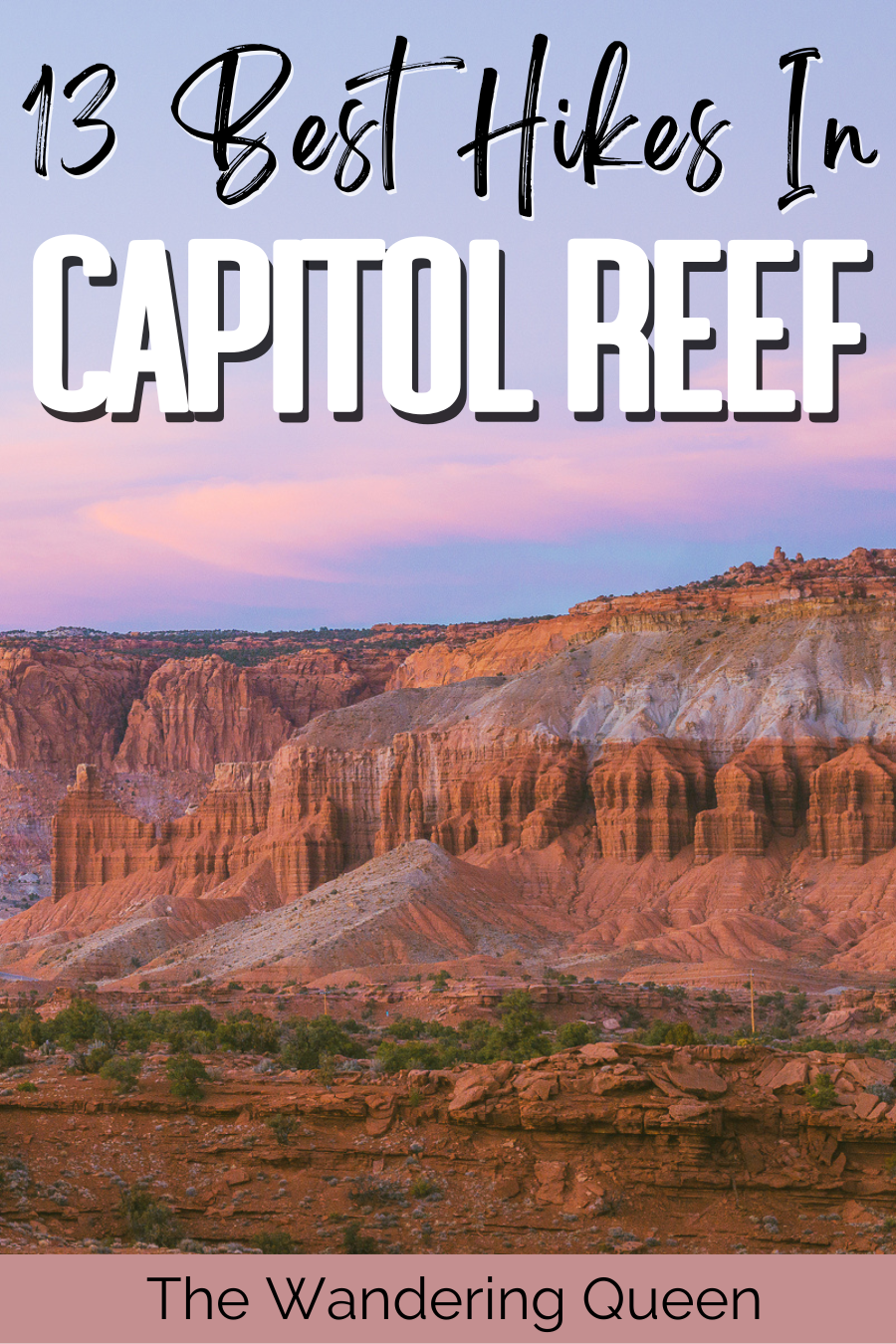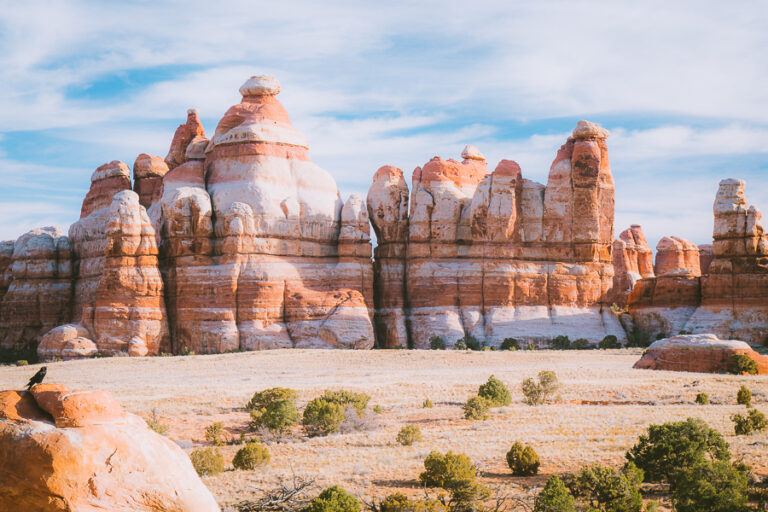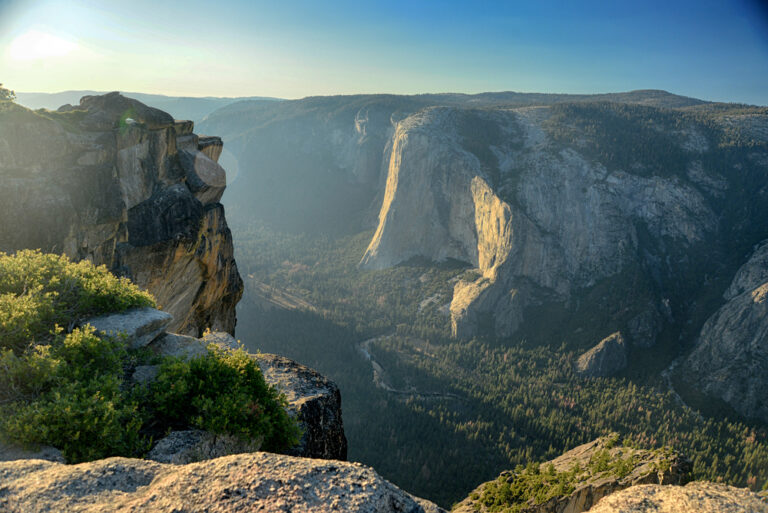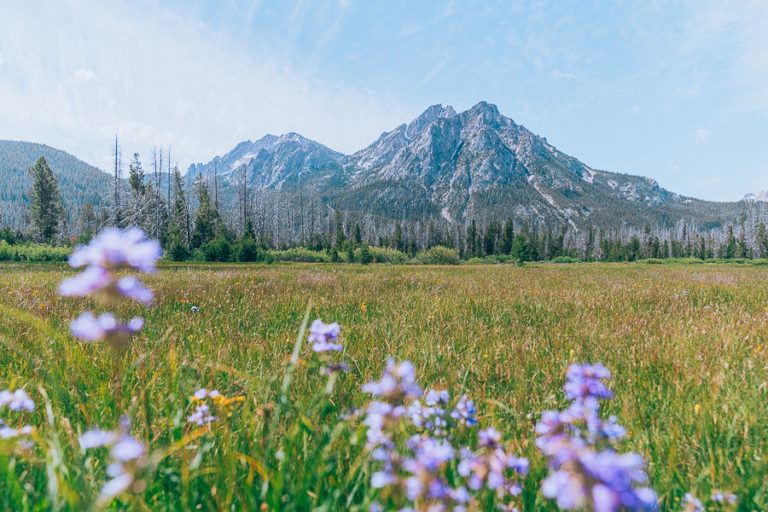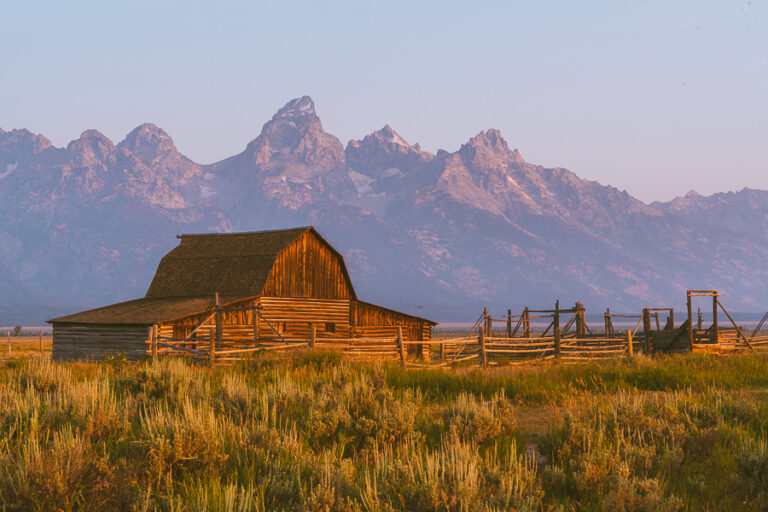Best Capitol Reef Hikes | 13 Exciting National Park Hiking Trails
If you’re taking a road trip through Utah’s Mighty Five, then Capitol Reef National Park cannot go unmissed. With its dramatic red cliffs and interesting sandstone and rock formations, there are plenty of exciting sights and wonders waiting to be explored.
Capitol Reef is not as popular as some of the other Utah national parks, so chances are you’ll have most of the park to yourself. This way, you can truly take in all that this off-the-beaten-path destination has to offer.
One of the best ways to experience Capitol Reef is by foot. The park is known to be a hiker’s paradise. Here you’ll find a plethora of trails exploring the never-ending red rock canyons and steep cliffs. And there are trails to suit all levels of hikers, from easy hikes with stunning scenery to others that are more challenging and daring.
Wondering what trails you should be tackling? Here is a guide on the best Capitol Reef hikes to ensure you get the most out of your visit.
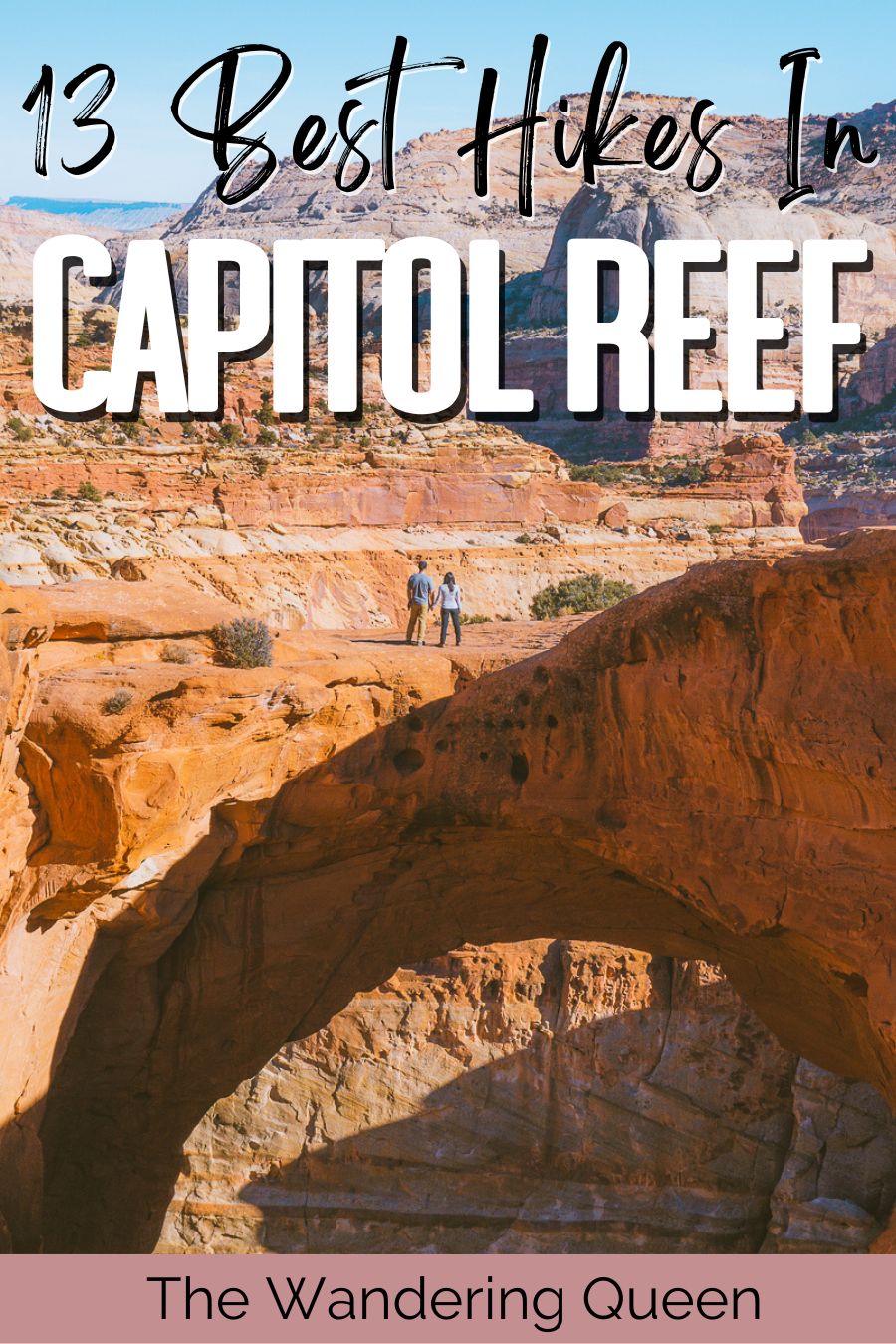
Disclosure: This post contains affiliate links. If you click one of them, I may receive a small commission (for which I am very grateful for) at no extra cost to you.
Capitol Reef National Park
Related Posts
Capitol Reef Trail Map
Where To Stay for Capitol Reef National Park Hikes
Wondering where to stay when visiting Capitol Reef National Park? Here are some of the best accommodation options. Each of these provides a comfortable place to rest between each of your outdoor adventures.
Luxury: Capitol Reef Resort
If you’re seeking luxury accommodation, then look no further than the Capitol Reef Resort. This stunning hotel sits right at the entrance of the national park and provides a comfortable base from which to explore.
There are plenty of stylishly-appointed rooms—each with garden or mountain views. There are also unique accommodation options, such as teepees and Conestoga wagons.
The hotel features an array of world-class amenities for guests to enjoy. This includes an outdoor swimming pool, state-of-the-art gym, a hot tub, and plenty more. >>>Check Availability
Mid-range: Days Inn by Wyndham Capitol Reef
Located 5 minutes from Boulder Mountain Scenic Highway and a short drive from Capitol Reef National Park is the simple yet comfortable Days Inn.
This property features spacious rooms equipped with all the amenities needed for a pleasant stay. There is also an indoor swimming pool and a hot tub for guests to enjoy following a day of activity.
Additionally, the hotel offers a free grab-and-go breakfast each morning. >>>Check Availability
Budget: Austin’s Chuckwagon Motel
For those on a tighter budget, check out Austin’s Chuckwagon Motel. This rustic accommodation is situated in Torrey, so you’ll have direct access to all that Capitol Reef has to offer.
At the motel are a variety of rooms fitted with flatscreen TVs, a bathroom, and a seating area. Some also have a kitchen, though the restaurant and snack bar are sure to have you covered.
There are several amenities on the premises, including a seasonal pool and hot tub. >>>Check Availability
Read More: Where to Stay Near Capitol Reef National Park | 12 Best Hotels
Camping: Fruita Campground
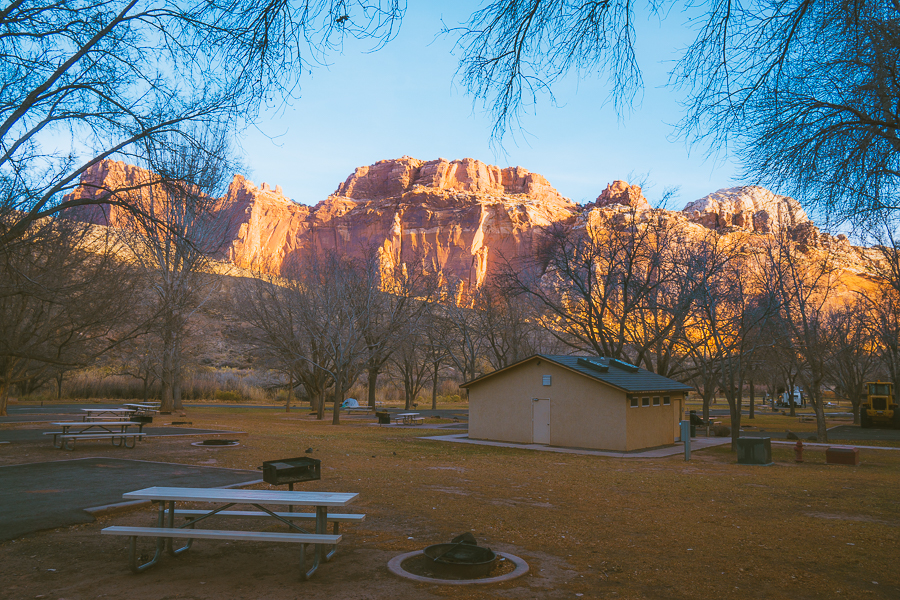
If you’re looking to experience the true essence of Capitol Reef, then camping is the way to go. Described as an oasis within the desert, Fruita Campground provides a comfortable resting place for people visiting the park.
The 71 camping sites are situated along the beautiful Fremont River, surrounded by orchids. Accommodation here costs around $25 per night. Between March 1st and October 31st, you will need to make a reservation beforehand as the park tends to be busy during this time.
There are also opportunities for primitive camping and backpacking within the national park, though a permit is required. >>>Find out more
Tours At Capitol Reef National Park
What To Pack For Best Capitol Reef Hikes
Sunscreen: This is needed all year long! >Buy some sunscreen, so you don’t accidentally burn!
Hiking Boots/Shoes: Hiking shoes or boots are needed for Capitol Reef. Don’t hurt your feet hiking in regular tennis shoes. >Buy my Hiking Shoes
Hiking socks: Having the correct socks helps you prevent getting blisters. Smart Wool is probably my favorite brand out there. I also love how they now have pink socks too 🙂 >Buy Hiking Socks
Refillable water bottle: I always bring a Hydroflask on all my adventures. They are on the heavier side, but I know for a fact they will not break. I have had a few cheap water bottles break on me before. >Check Prices Now
Water: Hiking, for sure, requires water.
Sunglasses: I usually wear the most fashionable sunglasses when I hike. 🙂 >Check Out These Sunglasses
Snacks: The best snacks are jerky, nuts, energy bars for hiking. >Clif Bars are great for hiking so click HERE.
Trekking Poles: This is an optional product, but they help with the knees. The poles I have listed are known to be one of the best in the market. >Buy My Trekking Poles Here
Camera: I have linked the camera I used to take pictures of Capitol Reef. The Sony A6000 is an excellent camera for people that want to start improving at travel photography. >Buy Sony Camera Here
First Aid Kit: This is one of the first things I bought when I first started backpacking and camping. It is super portable. >Buy This Awesome First Aid Kit Here
Day Pack: The REI bag I have linked, we have had for seven years now, and it is still going strong! >Buy This Great Quality Backpack
Good hiking pants or shorts: These are probably the best hiking pants that I have found. If you are hiking in the summer bring some shorts. It will get hot! >Buy my hiking pants here
Breathable sweat-wicking shirts
Sports Bra: For women. >Check Out This Awesome Sports Bra
Jacket: This is needed in the Fall and winter. Also, it might be chilly at night. >Buy My Favorite Jacket
Tripod: This is an optional item, but it is excellent for getting the perfect sunset pictures. >Check out this tripod
Headlamp: Just in case you get stuck hiking at night! >Buy A Headlamp Now
National Park Pass: I highly recommend getting a year-long America The Beautiful Pass. >>>Get It Here
Map: I love the National Geographic Maps! They are the best! >Buy One Here
Claim your FREE Hiking Checklist
Ready to start hiking? Grab my free hiking checklist and never forget anything at home!
Directions To Capitol Reef National Park
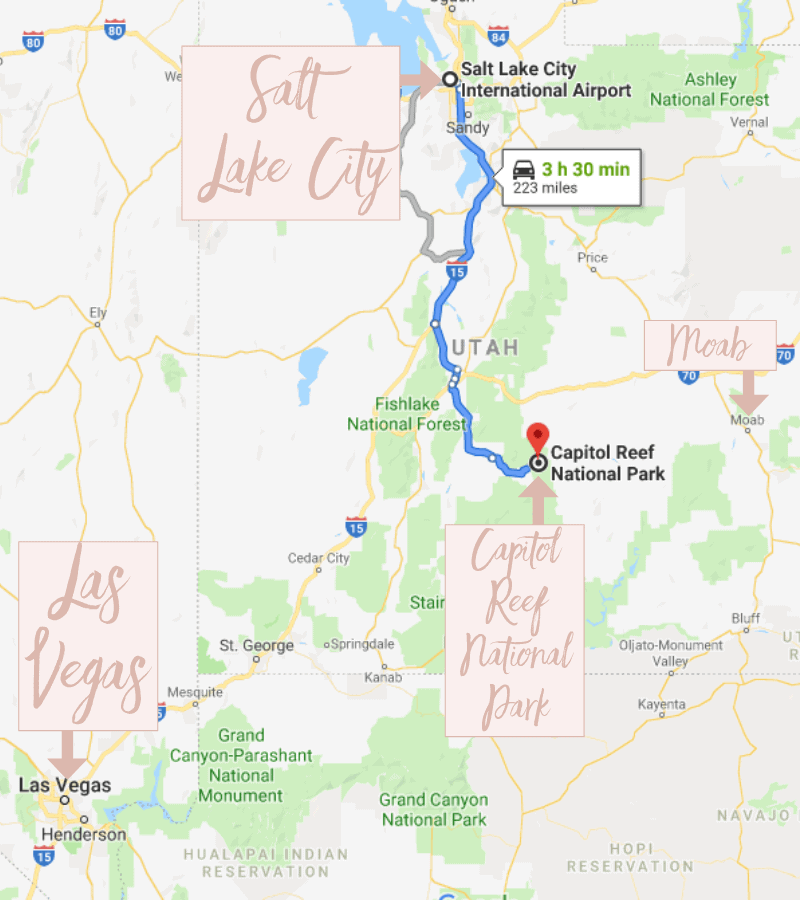
Capitol Reef feels like it is in the middle of nowhere. It can be challenging to get to, but that’s what I love about it. The park has fewer crowds than most national parks. We flew in from Salt Lake City, rented a car, and drove down to Capitol Reef.
- From Salt Lake City: 322 miles, 3 1/2 hours
- From Moab: 137 miles, 2 hours, and 15 minutes
- From Las Vegas: 338 miles, 5 hours, and 20 minutes
13 Best Hikes in Capitol Reef National Park
If you’re looking for breathtaking and awe-inspiring viewpoints in Capitol Reef, then look no further than the trails listed below. Each of these takes you to some of the most spectacular sights in Utah, including the beautiful red rock canyons, cliffs, waterfalls, and more.
Hickman Bridge
- Elevation Gain: 417 feet
- Mileage: 1.7 miles
- Difficulty: Easy
- Trail Guide: Link
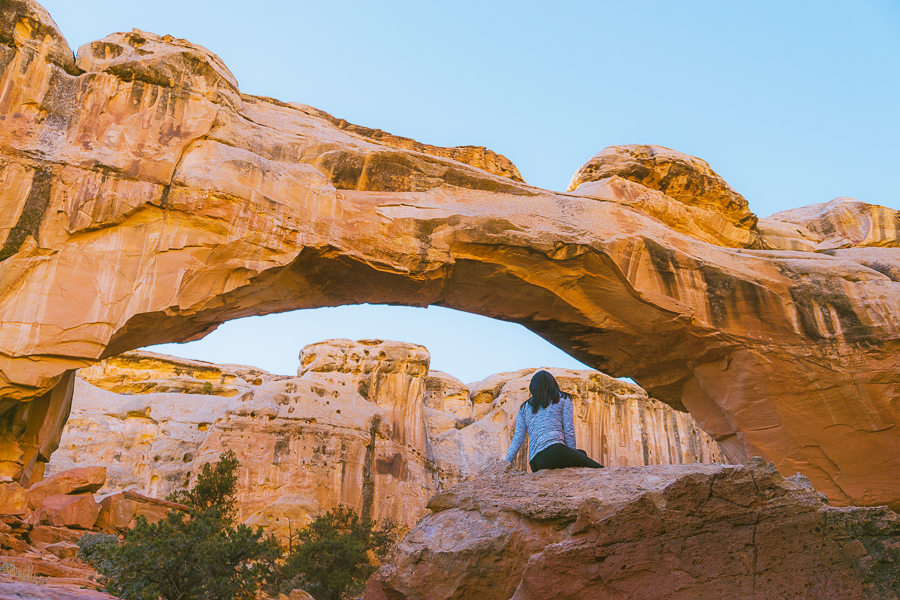
To start easy, here is one of the lighter hiking trails in Capitol Reef. The Hickman Bridge trail begins just 2 miles east of the national park’s visitor center and takes hikers on a scenic journey toward a large natural arch.
The large arch is Hickman Bridge, one of Capitol Reef’s most famous sites. It sits 300 feet above the beautiful Fremont River and is nestled comfortably amongst the natural surroundings of the Waterpocket Fold.
In addition to Hickman Bridge are several other sites for you to see. The first is a small Fremont put house ruin, which can be found near one of the switchbacks. Shortly after, you’ll come across a granary, as well as a miniature arch known as the Nels Johnson Natural Bridge.
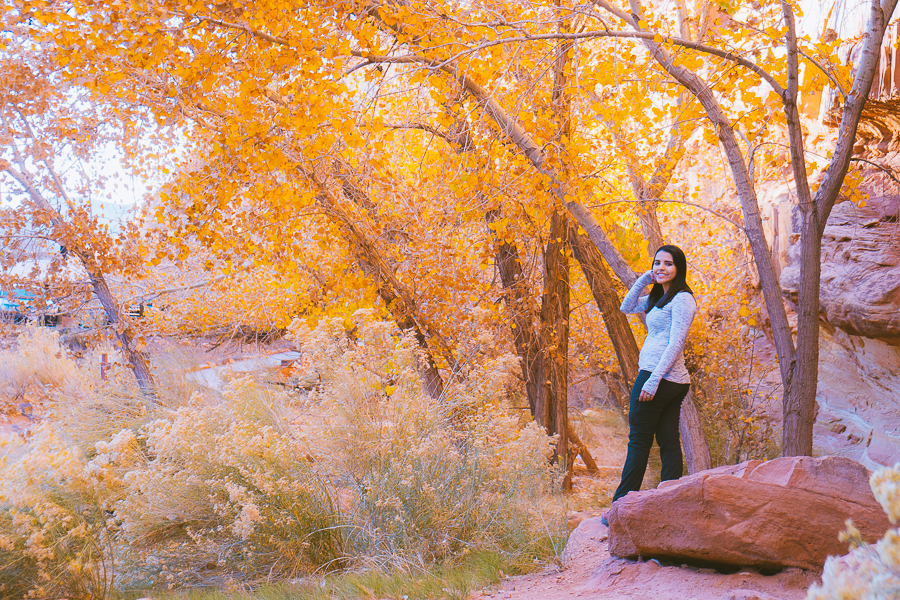
There are also a number of viewpoints scattered along the trail. The best one is the Fremont River overlook, which offers incredible views of Hickman Bridge and the mouth of Cohab Canyon.

Tip: Visiting on a national park road trip? You’ll find plenty of parking at the Hickman Bridge trailhead, situated along Highway 24.
Grand Wash
- Elevation Gain: 341 feet
- Mileage: 5.0-mile round trip
- Difficulty: Easy
- Trail Guide: Link
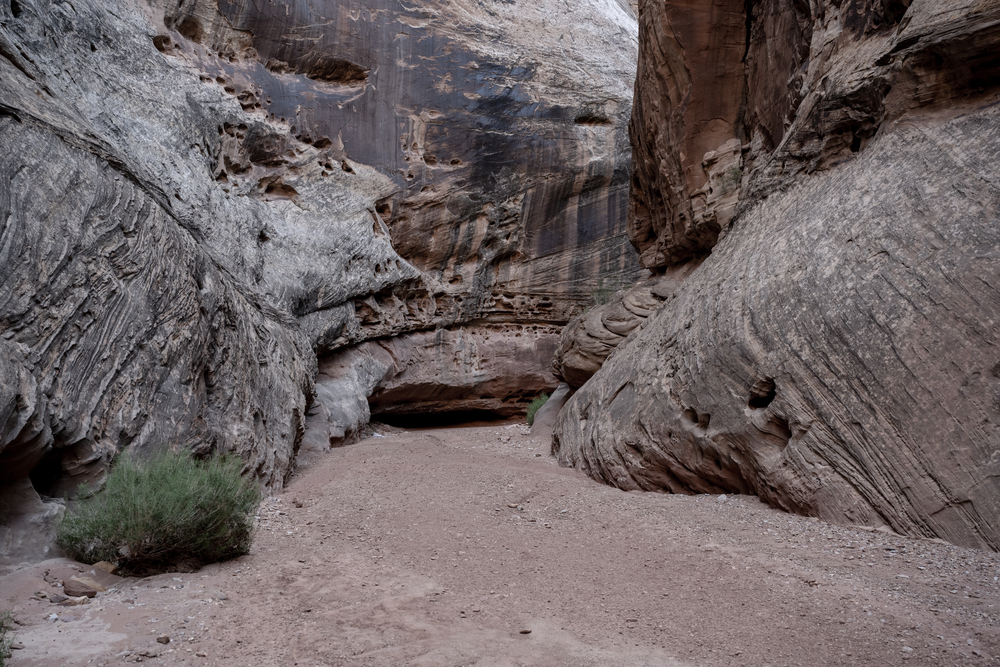
Grand Wash is another great family-friendly hike in Capitol Reef. The attraction is a famous gorge that cuts through the Waterpocket Fold, traversing between the Scenic Road and Fremont River.
The Capitol Reef trail begins at the Grand Wash northeast trailhead. This is located along the lower end of the Waterpocket Fold, which is around 300 feet below the southwest trailhead. As such, you’ll experience a slight elevation gain during the hike.
Nearing the end, you’ll come across the Grand Wash narrows. For about half a mile, the trail closes in and becomes tighter. To many, it resembles the famous narrows in Zion National Park.
The short and narrow stretch takes hikers past Cassidy Arch towards Highway 24. Here, hikers can choose to hike back to the Scenic Road or catch a shuttle back from the trailhead.

Tip: For those looking to travel further, you can hop straight onto the Cassidy Arch Trail, followed by the Frying Pan Trail.
Goosenecks Overlook and Sunset Point
- Elevation Gain: 2.5 miles
- Mileage: 544 feet
- Difficulty: Easy
- Trail Guide: Link
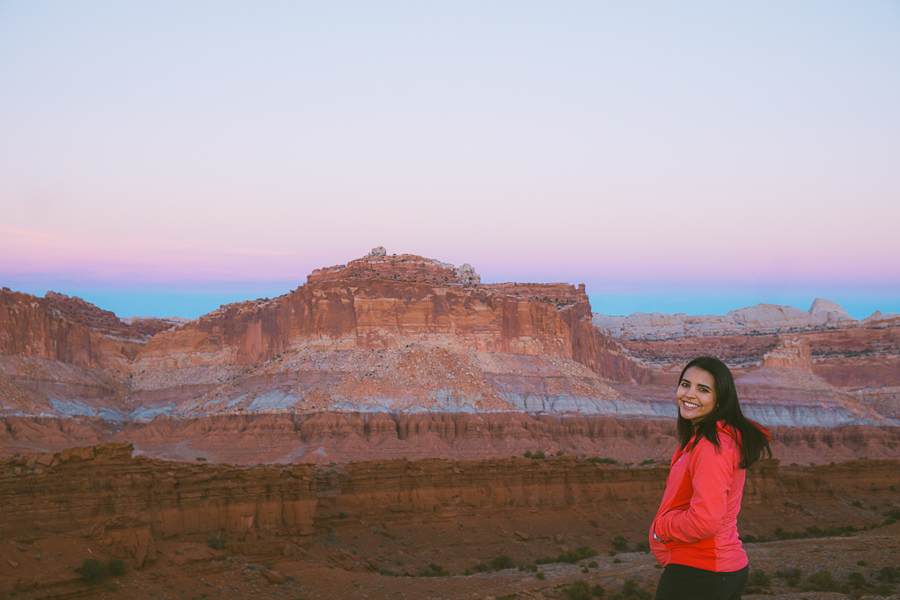
Sunset Point is one of the most popular spots in Capitol Reef. It is accessible via a short and easy hike and provides incredible sunset views. Whether it be a clear or cloudy day, you’ll find plenty of hikers at this viewpoint trying to catch a glimpse of this unique spectacle.
Sunset Point is a favorite amongst photographers, so be sure to bring your camera gear along, too.
For the most part, this Capitol Reef National Park hiking trail is flat—making it a great option for families. The trail begins near the Capitol Reef visitors center. The relatively easy path takes hikers towards the Panorama Point overlook before extending to the two main viewpoints—The Goosenecks Overlook and Sunset Point.
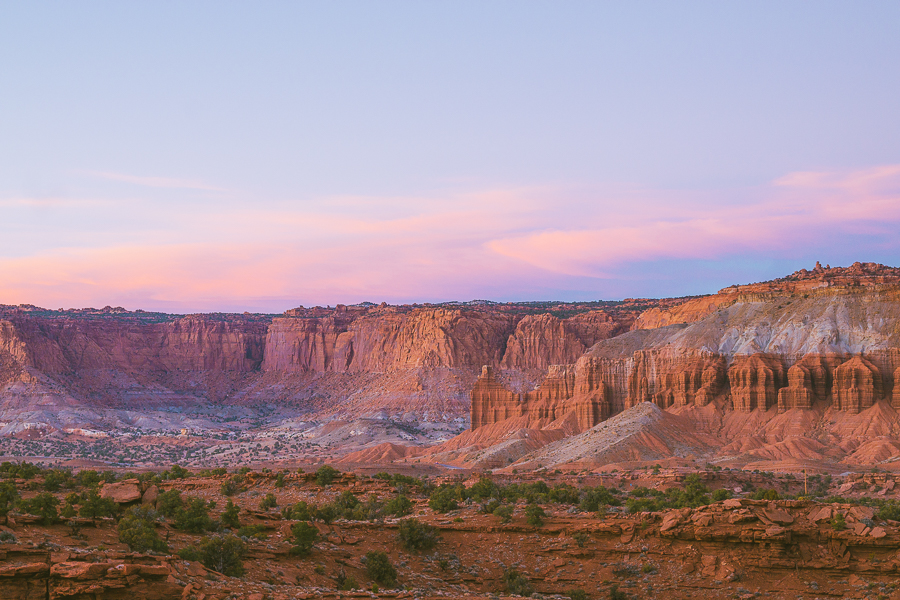
Upon reaching the viewpoint, you’ll be met by breathtaking views of the beautiful Utah national park. Once you are done enjoying the sunset, turn around and follow the same route back to the trailhead.
Cassidy Arch
- Elevation Gain: 666 feet
- Mileage: 3.1 miles
- Difficulty: Moderate
- Trail Guide: Link
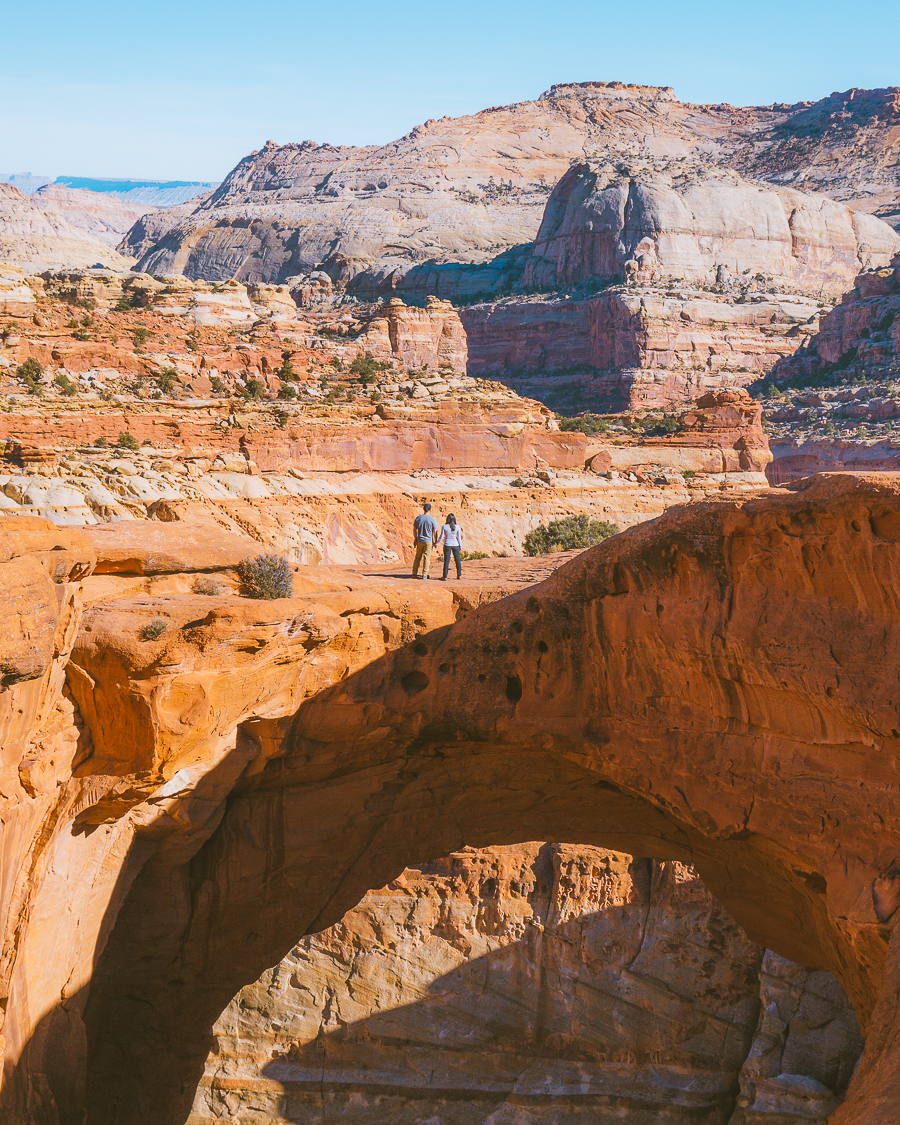
Cassidy Arch is one of the most popular Capitol Reef trails. It follows a moderate out-and-back route to one of the national park’s many famous landmarks—a natural sandstone formation named after Wild West outlaw Butch Cassidy.
Compared to the previously mentioned hikes, the Cassidy Arch trail poses a slightly greater challenge. There are several sections that are completely exposed, so it is not the most family-friendly option on this list. It’s also not ideal for those who have a fear of heights.
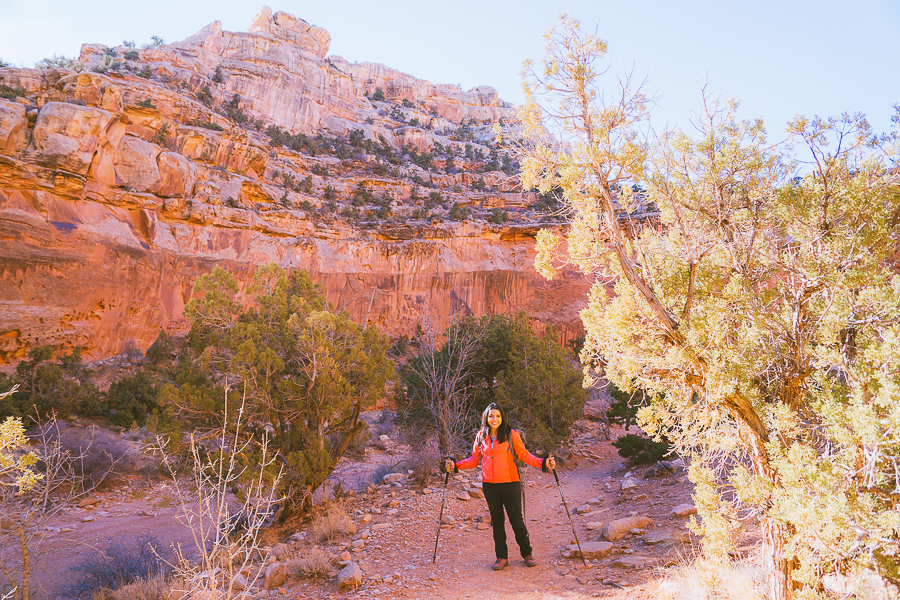
While challenging, you are guaranteed spectacular views of the Utah desert. And best of all, it does not take long to complete. Once you’ve reached the arch, you can choose to turn back or extend your hike further by transitioning to the Frying Pan or Grand Wash trail.
Download my free Outdoor Photography Guide
Capitol Reef Petroglyph
- Elevation Gain: 49 feet
- Mileage: 0.31 miles
- Difficulty: Very easy
- Trail Guide: Link
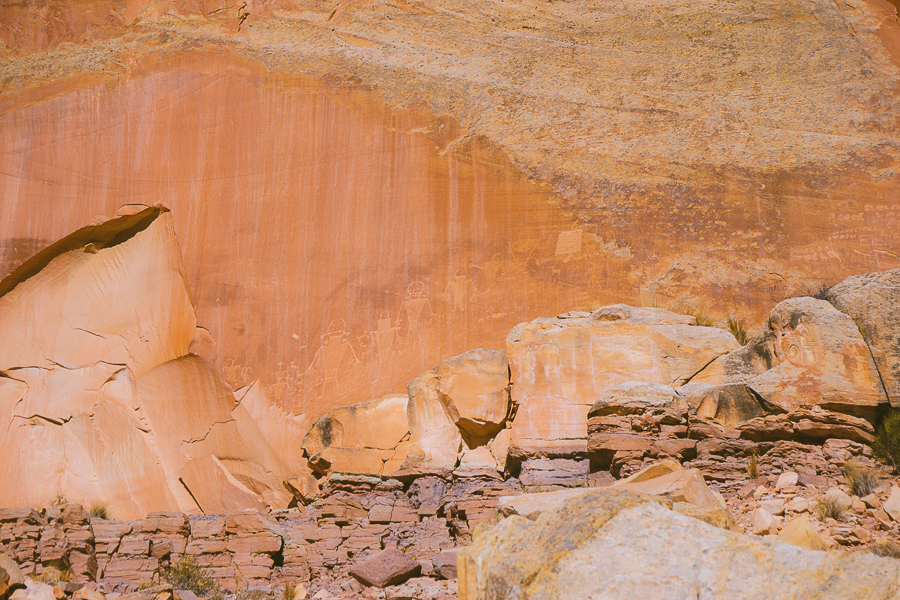
The Capitol Reef Petroglyph Trail is one of the shortest hikes found in the Utah national park. From the roadside stop, the 0.31-mile trail takes visitors toward a beautifully preserved petroglyph panel.
The petroglyphs are a series of drawings created by the Fremont people. These were farmers, hunters, and gatherers who lived along the Fremont River between 700 and 1,400 years ago.
A trip to these unique drawings follows an easy out-and-back trail and is the perfect option for families visiting Capitol Reef. In addition to being short, the route experiences very little elevation gain, and it is stroller-friendly and wheelchair accessible, too.
Once you’ve reached the petroglyphs, spend some time looking around and reading the interpretive signage. Then, you can head back the way you came and call it a day or continue on to the Fruita Trail.

Note: Avoid touching the petroglyphs so that the unique piece of history can be preserved for generations to come.
Cohab Canyon
- Elevation Gain: 793 feet
- Mileage: 3 miles
- Difficulty: Moderate
- Trail Guide: Link
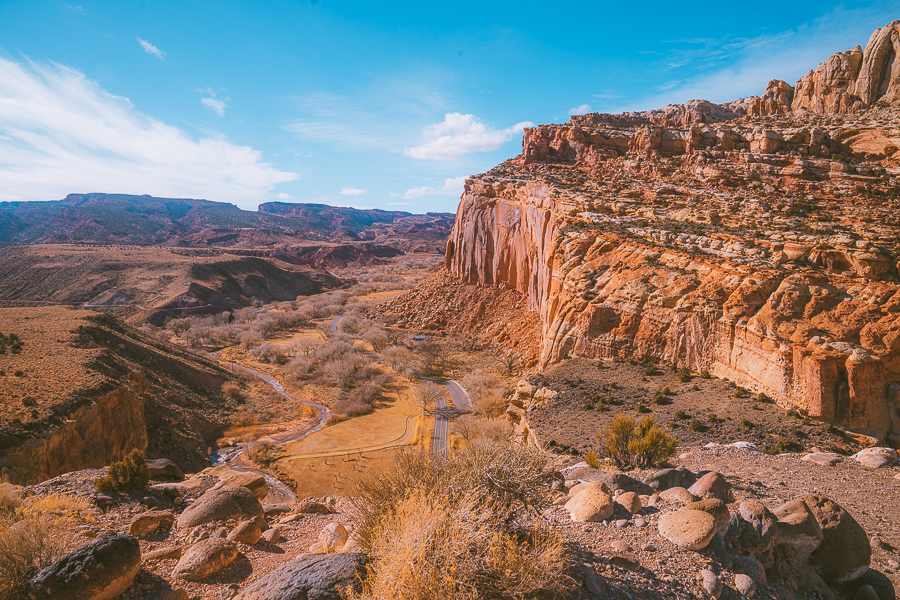
For those seeking a moderately challenging trail with gorgeous views, the Cohab Canyon trail is a good pick. The trail offers some of the best views of the national park and features plenty of shade along the way.
While it may sound leisurely, the hike begins with a steep climb that is sure to have your legs burning. As such, walking poles and a good pair of hiking boots are highly recommended for those tackling this trail.
Following the climb is a steep descent into Cohab Canyon. Here you’ll be met by stunning views of Fruita and Boulder Mountain. Continue down, and you’ll pass by several more attractions, including The Wives—a series of short canyons.
If you have the time, be sure to explore these side canyons, as they are well worth the detour. Once you’ve made your way out the saddle, you’ll find yourself at a trail junction where you can choose to turn around or continue onto Frying Pan Trail or Highway 24 overlook.
Chimney Rock
- Elevation Gain: 793 feet
- Mileage: 3.3 miles
- Difficulty: Moderate
- Trail Guide: Link
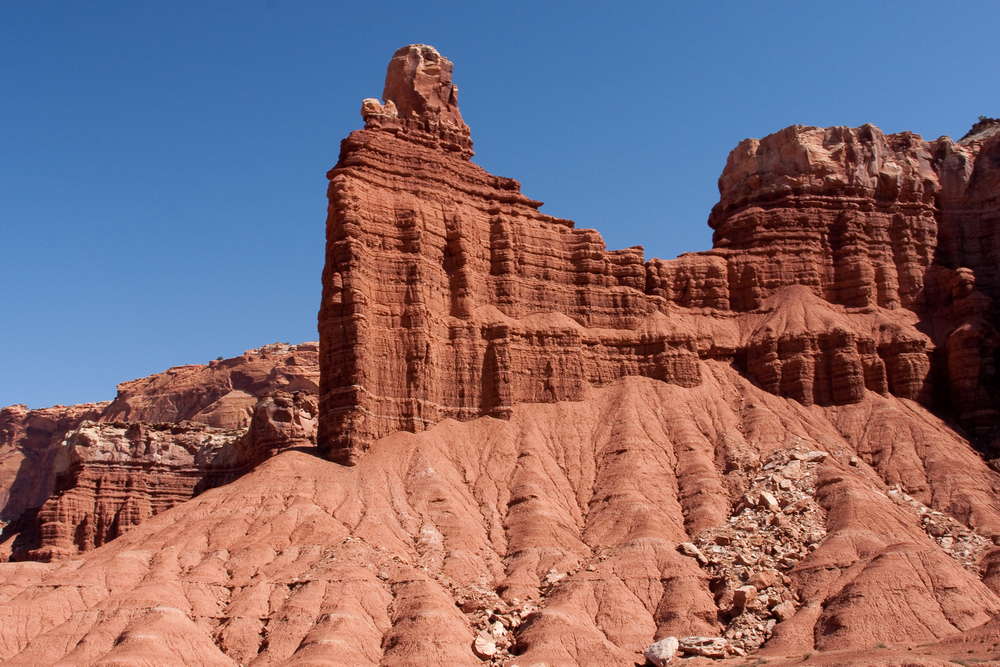
Chimney Rock Trail is relatively short and takes hikers up to a high elevation point while passing by many natural wonders. Among these is Chimney Rock itself, which is a popular historic landmark found within Capitol Reef National Park. It is a solitary pillar of Moenkopi sandstone that has been standing tall for approximately 245 million years.
The hiking trail offers quite a steep journey and ascends up along the red rock hills located on the northern end of UT 24. Before reaching Chimney Rock, you’ll pass by various sights, including colorful badlands and narrow canyons. You’ll loop around the top of Mummy Cliff.
Following this, you will pass close to Chimney Rock. Here you’ll find an incredible viewpoint and some exceptional photo-ops. Not far from here is the Chimney Rock trailhead, which marks the beginning and end of the loop. For those looking for more adventure, try the Sulphur Creek trail across the road.
Capitol Gorge Trail
- Elevation Gain: 374 feet
- Mileage: 4.5 miles
- Difficulty: Easy
- Trail Guide: Link
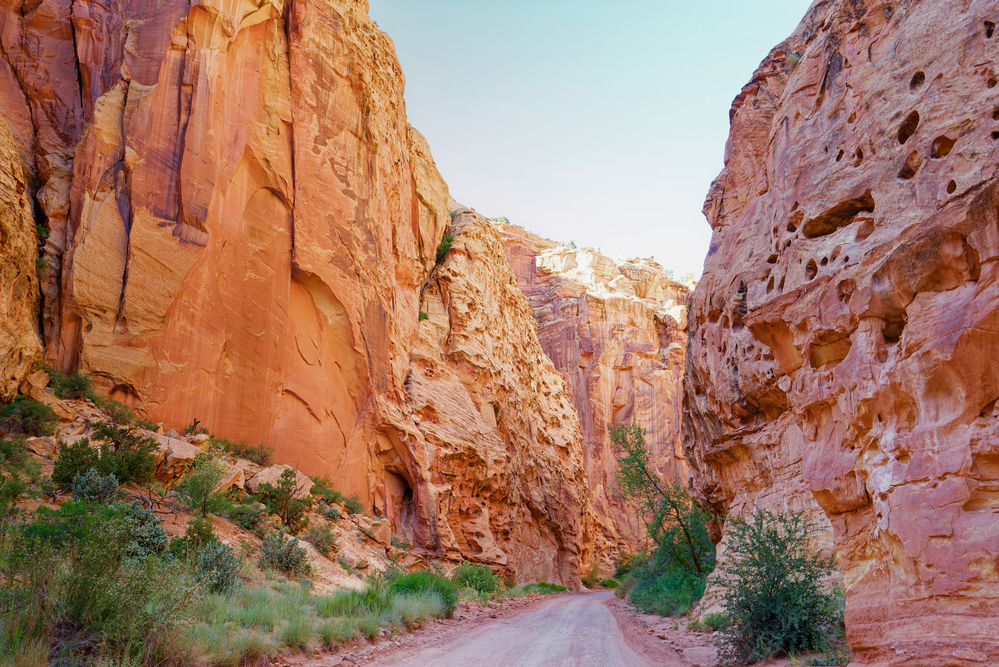
Located where Capitol Gorge Road ends is the relatively easy Capitol Gorge trail. This trail is mostly flat and passes by a number of historic treasures. Among these are faded petroglyphs, pictographs, and etchings left by early pioneers who traveled through the national park.
In total, the Capitol Gorge trail covers a distance of 4.5 miles. Just a quarter-mile in, you’ll come across the first set of petroglyphs. And around a half-mile in, you’ll find various names etched on the walls of the cliff. These date back to the late 1800s and early 1900s, when the gorge was open to wagon traffic.
Around the 1-mile mark, you’ll see the Tanks Trail sign. Head left if you wish to visit the tanks. These are hollowed-out sandstone pockets created by years of running water caused by snowmelt and flooding. Depending on when you visit, you may find these pockets filled with water.
If you do not have time for the detour, simply keep to the right and continue along the Capitol Gorge trail. Once you’ve reached the boundary, turn around and follow the same route back. For those seeking more, consider tackling the Golden Throne trail, too.

Tip: Arrive early, as parking near the trailhead is limited.
Rim Overlook
- Elevation Gain: 1,053 feet
- Mileage: 21 miles
- Difficulty: Moderate
The Rim Overlook Trail is one of the longest-maintained hiking trails in Capitol Reef National Park. The trail meanders up at a gradual pace, reaching an elevation of around 1,053 feet. Because of the steady incline experienced throughout, your legs are sure to get an incredible workout. However, the beautiful views promised at the top make it all worth it.
While reaching Rim Overlook is challenging, it is a great pick for healthy adults and older children. The trail begins near the Hickman Bridge Trailhead. Around a half-mile in, you’ll find a viewpoint offering an unobstructed view of the natural arch. From here, travel westward toward Rim Overlook.
For the best photo-ops, aim to reach the viewpoint around sunset. Watch in awe as the sun lights up the valley with shades of gold. When you’re ready, turn around and follow the same route back. Or, if you’ve visited earlier in the day, you can extend your journey by traveling toward the Navajo Knobs.
Grab Your Free Car Camping Checklist! 🚗🌲
Ready to elevate your car camping game? Snag our essential checklist to ensure you’ve got everything you need for a stress-free, fun-filled adventure! Perfect for beginners and seasoned campers alike. Download now and hit the road prepared! 🌟🎒
Navajo Knobs
- Elevation Gain: 2139 feet
- Mileage: 9.07 miles
- Difficulty: Hard
- Trail Guide: Link
For those seeking a real challenge, Navajo Knobs is a popular pick. Unlike the Rim Overlook Trail, this route takes you along the edge of the rim. The climb is also incredibly steep, so you will definitely need a good pair of hiking shoes and potentially hiking poles, too.
While reaching the knobs is taxing, the journey starts off being relatively easy. In the beginning, you’ll find a number of uphill and downhill sections. You’ll also pass by the Castle, which is one of the most noteworthy rock formations in the national park.
Then, you’ll be met by a steep climb towards the Navajo Knobs. There are no flat sections on this portion of the trail, and you’ll experience many twists and turns before reaching the top. But while the journey up is relentless, the destination is one that is sure to take your breath away.
From the top, you will have 360-degree views over the Utah desert. See the national park in all directions. Look north towards the Cathedrals district and south over Fruita and Highway 24.
Unlike most out-and-back trails, this one offers a unique experience on the way back to your car. See sights like the white Navajo sandstone formations and enjoy the downhill walk.

Tip: For the full experience, do Rim Overlook and Navajo Knobs together and start your hike as early as possible.
Cathedrals Trail
- Elevation Gain: 324 feet
- Mileage: 2.5 miles
- Difficulty: Easy
- Trail Guide: Link
Cathedrals Trail is located within Capitol Reef’s northern Cathedral District. Here the northern flanks of the Waterpocket Fold give way to a number of natural wonders, including stunning monoliths and interesting volcanic dikes and crags.
The short out-and-back trail takes hikers along a low ridgeline that runs parallel to a series of monoliths known as the Cathedrals. The trailhead is located on Cathedral Road, where a small wooden sign marks the beginning of your journey.
Early on, you can expect a steep but steady climb. While the initial ascent can be a challenge, this is still considered an easy hike as the rest of the trail is mostly flat. As such, the Cathedral Trail is popular amongst families visiting the national park.
At the end of the 2.4-mile trail, you will reach an overlook. Here you’ll have panoramic views of the Cathedrals, as well as the Upper Cathedral Valley.

Note: This is a great trail for those seeking more solitude as it explores some of the national park’s most remote territories.
Lower Cathedral Valley Overlook
- Elevation Gain: 150 feet
- Mileage: 1.7 miles
- Difficulty: Easy
- Trail Guide: Link
Another trail offering views over some of the national park’s most sought-after monoliths is Lower Cathedral Valley Overlook. This trail is not as popular, as many visitors opt to view the Temples of the Sun and Moon from the valley. However, seeing these monoliths from the top down provides a spectacular view and a pleasant experience, too.
Reaching this unique vantage point involves a short and easy hike. The trail begins near Hartnet Road with a relatively flat walk. Shortly after, you will experience a steep climb towards one of the saddles. From the rim, you will be able to enjoy incredible views of Lower Cathedral Valley and the two famous monoliths.
There is a second saddle that provides views over the valley; however, the two are not connected by a cairned route. You will need to identify the faint path that connects the two saddles and traverse across. Then, continue to the trailhead to complete the loop.

Note: To access this trail, you will need a 4×4 high clearance vehicle.
Strike Valley Overlook
- Elevation Gain: 400 feet
- Mileage: 6.2 miles
- Difficulty: Easy
- Trail Guide: Link
The Strike Valley Overlook Trail is a relatively easy hike that ends atop a scenic overlook, providing views over the Waterpocket Fold, Strike Valley, and plenty more.
The trail begins on the northwest end of the Strike Valley parking area. In the early stages, the hike follows a sand trail and passes through pinyon pines and junipers. Then, it drops into a shallow wash. From here, it is easy to ascend along the side of the wash.
Around a half-mile in, you’ll find yourself on the ridge atop Waterpocket Fall. Here you’ll be able to wander around and take in views of Strike Valley and the contorted rock formations located along the side of the Fold.
You’ll also see the Henry Mountain Mountains, Upper Muley Twist Canyon, and the Tarantula and Swap Mesas. And on a clear day, you’ll be able to spot the domes of Capitol Reef in the distance.
Best Time To Go Hiking in Capitol Reef
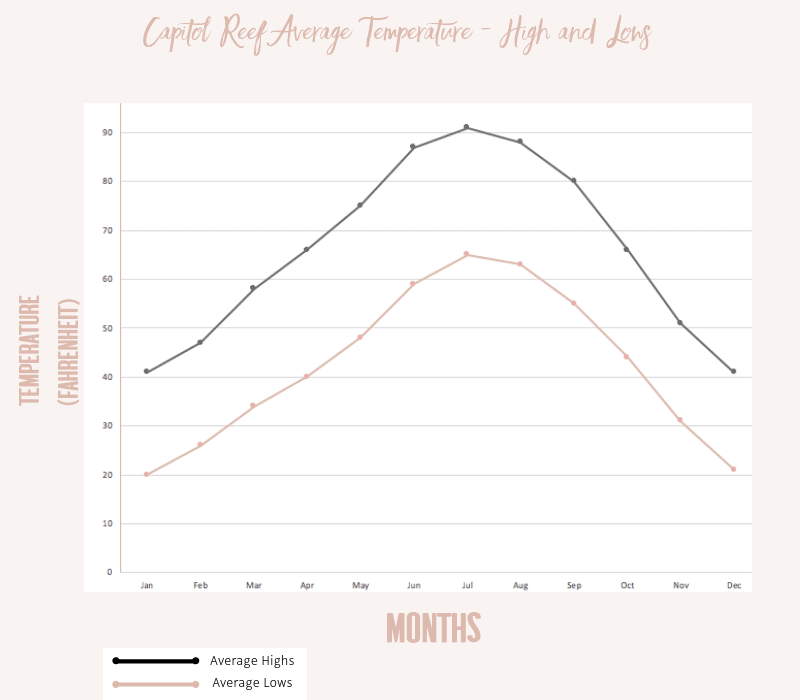
To most, the best time to visit Capitol Reef National Park is during spring or fall. This is because the seasons bring about fewer crowds and pleasant weather that is suited to hiking. And while Capitol Reef is an arid desert park, you can still expect some beautiful sights, be it the spring blooms or fall colors.
The summer months experience sweltering temperatures and larger crowds; however, these crowds are fewer than what you might find at Zion National Park or Bryce Canyon.
Winter, on the other hand, offers smaller crowds. While this is favorable, the snow and freezing temperatures are not ideal for those looking to hike. Additionally, several roads may be closed, so getting around the park may not be as easy.
While spring and fall are considered the best times of year for visiting Capitol Reef, the park is open year-round. And although winter and summer have their downsides, both seasons have their own unique charms, too. Winters are great for those seeking quiet and solitude, whereas summers are ideal for swimming in the park’s many rivers and streams.
Read More: Best Things To Do In Capitol Reef National Park
How Many Days Do You Need for Hikes in Capitol Reef
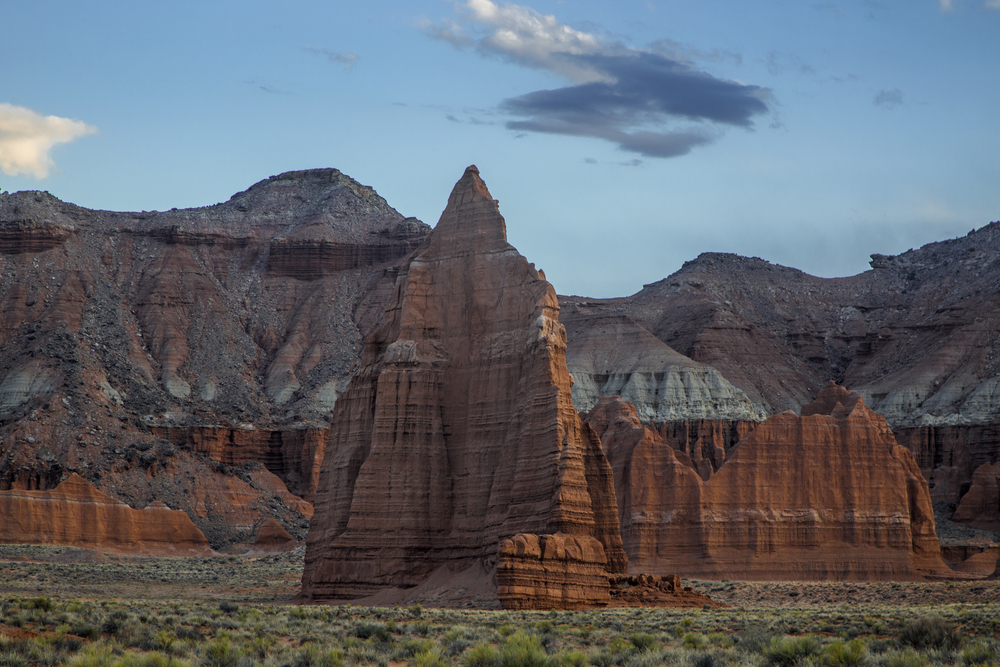
The length of time you’ll need in Capitol Reef National Park is dependent on the time of year your visit and the type of activities you plan to do.
Capitol Reef is a relatively compact park when compared to some of the other members of the Mighty Five. So, you can experience most of the national park’s top attractions within a day. Even half a day has proven to be enough for some.
However, for those looking to hike and explore the backcountry, several days in the park will be needed. Capitol Reef features a variety of trails that cover different areas within the park. If you wish to see everything from Highway 24 and Torrey to Boulder and Escalante, a minimum of two to three days is recommended.
Tips for the Best Hikes – Capitol Reef National Park
Whether you’re a beginner or a more experienced hiker, there are a few things you should keep in mind before hiking in Capitol Reef. The conditions and diverse landscape make even the simplest of hikes a challenge. To ensure you have a safe and enjoyable trip, check out the tips below:
- Wear layers: the weather conditions can be unpredictable, and wearing layers will ensure you’re prepared for anything.
- Prepare for the sun: be sure to use a good sunscreen, whether you’re visiting on a warm or colder day. You can also wear a sun hat or cap with a visor for extra protection.
- Bring lots of water: some Capitol Reef National Park trails do not offer reliable sources of water. As such, it is important to bring along at least one gallon of water per person.
- Check the weather: before your hike, check the weather to ensure the conditions are favorable. This is especially true for the sweltering summer and freezing winter months. The park is also prone to flash floods.
- Check the road conditions: it is important to get a report on the road conditions as some roads in the park may be closed.
- Bring along insect repellent: deer flies are relentless in some parts of this national park, so be sure to include insect repellent in your hiking gear.
- Ensure you have the right shoes: some hiking trails require heavy hiking boots, while others may need something light or waterproof.
- Use seal bags: Some trails include river crossings, so be sure to bring along heavy-duty plastic bags to store your belongings safely.
- Use a map: while the park is not the largest, it’s easy to get lost. As such, be sure to use a map when hiking. You can pick up one at the visitor center or download one here.
- Research your hiking trail: to know what you’re getting yourself into, read the trail description of the hike you are planning to do. This way, you’ll be more prepared.
- Bring plenty of food: There are no stores within the national park, so bring plenty of food. This is especially true if you are camping. Check out this guide on camping for beginners.
- Respect the wildlife: there are around 60 species of mammals in Capitol Reef, including black bears. To ensure the safety of you and the animals, check out these wildlife safety tips.
- Do not litter: just as it is important to respect wildlife, it is also important to respect the environment. So whether you’re camping or visiting on a day hike, be sure to leave no trace of your visit.
- Stay on the established trails: for your safety, stick to the trails and do not shortcut any switchbacks.
- Do not build new cairns: many hiking trails are marked with cairns, and building new ones may confuse other hikers.
- Bring the correct gear: some trails are incredibly steep, so you may need additional gear, such as a walking pole. Wondering what else to bring? Check out this hiking gear list.
Discover The Best Capitol Reef Hiking Trails
There you have it, some of the most exciting trails to explore in Capitol Reef. With its dramatic cliffs, interesting red rock formations, and diverse landscape, there is plenty to explore in this national park.
Whether you want an easy hike that takes an hour or less or a challenging trek that lasts all day, Capitol Reef has it all. So what are you waiting for? Get outside and tackle some of these incredible Utah hiking trails!

More Posts About Utah
